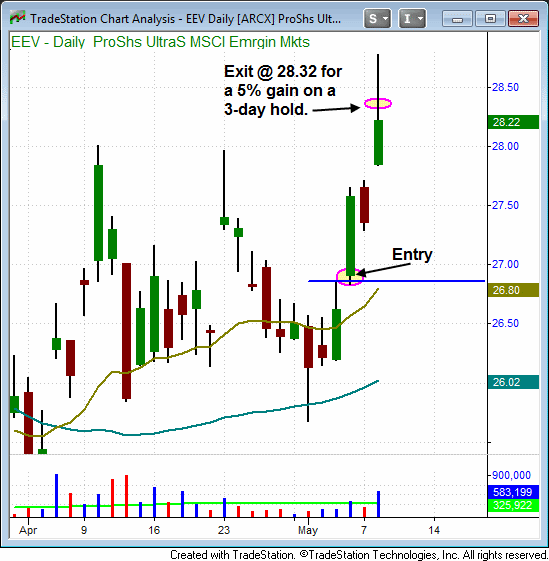Recently, we entered a swing trade in ProShares UltraShort MSCI Emerging Markets ($EEV). Inversely correlated “short ETFs” such as EEV are designed to move in the opposite direction of their underlying index. This allows us to basically sell short the underlying index through buying (going long) the inverse ETF. In this case, buying EEV was the same as taking a bearish position on the MSCI Emerging Markets Index (note that “short ETFs” are designed to be used only for quick, short-term trades).
In our May 4 newsletter, subscribers of The Wagner Daily were alerted to a potential buy entry in EEV above the high of May 3. We liked the reversal bar action on May 1, followed by the false trigger on May 3, which provided a clear entry point above the May 3 high. The chart below details the technical buy setup prior to our entry:

That day, EEV triggered its buy entry at $26.91, and subsequently followed through nicely to the upside, closing at its high of the day on above average volume. Because the broad market was selling off sharply and approaching near-term oversold levels, EEV was taken as a very short-term trade (2-5 days), as we were looking to sell into strength on a breakout above resistance at the $28.00 area. Due to the sharp selling action in the market on the morning of May 8, EEV broke out above $28.00 and hit our price target of $28.32, allowing us to neatly book a 5.5% gain on just a 3-day hold. The exit point is shown on the chart below:

To participate in our next big winner, click here to get started with your membership to our nightly, end-of-day ETF and stock newsletter today, from less than $2 per day (based on annual subscription). You may also wish to view our actual trade performance history or visit our free, educational archive of past newsletters.

Given the reversal bar on May 1st, why not buy on May 2nd rather than the higher price of 26.91 on May 6th?
@CuoreNero Good question. Actually, buying above the May 2nd high would have been perfectly acceptable as well, and entry price would have indeed been a bit lower. However, our individual trade entry and exit strategy is also based on our general broad market timing system, which increases the odds of success for individual trades.
On May 1, the S&P 500 formed a false upside breakout candle, and by May 2, it had sold off to close right at pivotal support of its 20 and 50-day moving averages. So, we wanted to see just a bit more confirmation that the broad market was headed lower as well before entering the EEV (which is an inversely correlated “short ETF”). That broad market confirmation came on the day of trade entry on May 6.
Generally speaking, we are conservative traders. We usually don’t mind paying a bit higher price for a trade entry, in return for increased odds of the trade working out favorably.
Hope that helps.
Deron
Thanks.
Do you have more examples of short trades like this?
short as in 2-5 days (not necesarilly shorting)
Sorry about the late reply. I somehow missed your comment that was pending approval on the blog.
Anyway, there are many examples of trades like this, where we buy above the high of the reversal bar. Check the category (on right sidebar of blog) to review the “actual past trades,” as well as “top stocks on our screener watchlist.” You will see more examples like this. In fact, the blog post I will be making today (re. $IBB) is this type of setup.
Hope that helps.